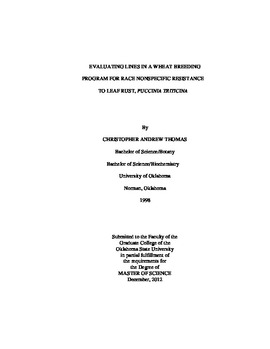| dc.contributor.author | Thomas, Christopher Andrew | |
| dc.date.accessioned | 2014-04-15T22:06:25Z | |
| dc.date.available | 2014-04-15T22:06:25Z | |
| dc.date.issued | 2012-12-01 | |
| dc.identifier.uri | https://hdl.handle.net/11244/9372 | |
| dc.description.abstract | Breeding resistance to leaf rust (Puccinia triticina) into wheat varieties has long depended on the incorporation of one or more race specific or “major” genes that confer complete resistance to specific rust pathotypes. This approach, though successful, is problematic because virulence quickly emerges in leaf rust populations to overcome resistance in extant varieties. Therefore, a new approach in breeding for leaf rust resistance is to pyramid many recessive race nonspecific or “minor” genes into wheat lines to produce spring wheat varieties with durable race nonspecific resistance was developed at International Center for Maize and Wheat Improvement (CIMMYT). CIMMYT has made these lines available to wheat breeders throughout the world. However, the use of these lines to breed for resistance in winter wheat lines is made difficult because race nonspecific genes are often recessive and have very little effect individually and are therefore, very difficult to select for using field selection methods such as the modified Cobb scale. To alleviate this problem and to allow selections for race nonspecific genes to be made, molecular markers for one race nonspecific leaf rust gene, Lr34, rust reactions of seedlings grown in the greenhouse, and adult plant field readings were combined to identify winter wheat lines with recessive race nonspecific genes. One hundred ninety-two advanced winter wheat lines made from crosses with the CIMMYT Spring wheat lines were screened for the presence of race nonspecific genes using this method. An additional two 243 lines were screened using greenhouse and field reactions alone. A total of 237 advanced winter wheat lines were found to have resistance derived from race nonspecific resistance, with 62 of these lines having resistance derived from three or more pyramided race nonspecific genes. These results indicate that combining greenhouse seedling rust reactions with field rust readings and molecular markers is an effective method to identify lines with leaf rust resistance derived from pyramided race nonspecific genes. | |
| dc.format | application/pdf | |
| dc.language | en_US | |
| dc.publisher | Oklahoma State University | |
| dc.rights | Copyright is held by the author who has granted the Oklahoma State University Library the non-exclusive right to share this material in its institutional repository. Contact Digital Library Services at lib-dls@okstate.edu or 405-744-9161 for the permission policy on the use, reproduction or distribution of this material. | |
| dc.title | Evaluating Lines in a Wheat Breeding Program for Race Nonspecific Resistance to Leaf Rust, Puccinia Triticina | |
| dc.type | text | |
| osu.filename | Thomas_okstate_0664M_12380.pdf | |
| osu.college | Agricultural Sciences and Natural Resources | |
| osu.accesstype | Open Access | |
| dc.description.department | Department of Plant and Soil Sciences | |
| dc.type.genre | Thesis | |
| dc.subject.keywords | durable resistance | |
| dc.subject.keywords | leaf rust | |
| dc.subject.keywords | minor genes | |
| dc.subject.keywords | puccinia triticina | |
| dc.subject.keywords | pyramiding genes | |
| dc.subject.keywords | race nonspecific resistance | |
